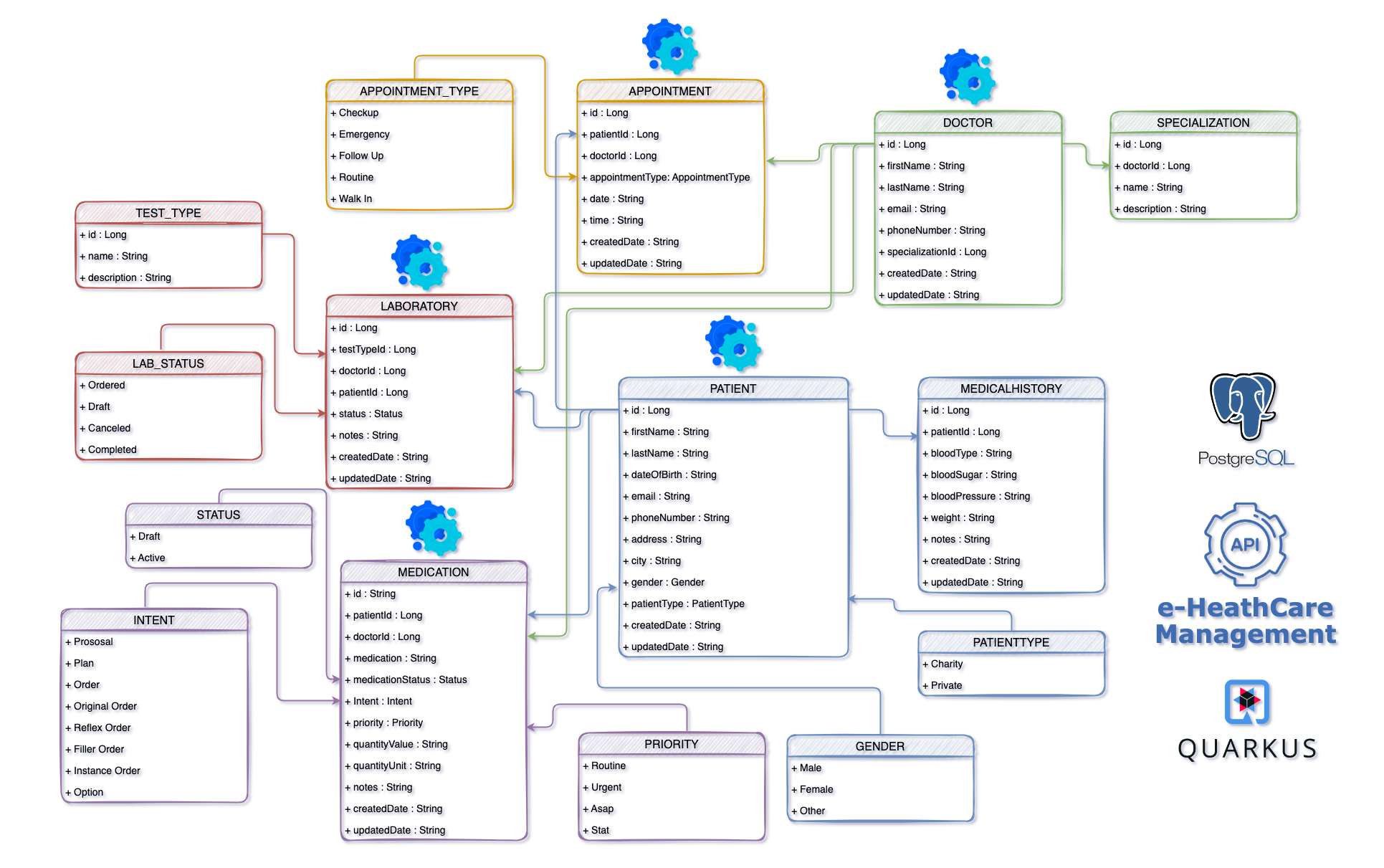Build E-Health Care Management API with Quarkus and PostgreSQL on Kubernets.
- Java
- Quarkus and Microprofile
- PostgreSQL
- Minikube and Kubernetes
- Hibernate-ORM
- Create Quarkus Project
- Project configuration
- Database source configuration
- Define database entities
- Define domain model
- Define service layer
- Define JAX-RS resource layer
- Define exception mappers
- Test
- Appointment Service
- Doctor Service
- Laboratory Service
- Medication Service
- Patient Service
The scheduling api for appointment and events.
- findAll - GET
/api/v1/appointments - findById - GET
/api/v1/appointments/{id} - findByDoctorId - GET
/api/v1/appointments/doctor/{id} - findByPatientId - GET
/api/v1/appointments/patient/{id} - create - POST
/api/v1/appointments - update - PUT
/api/v1/appointments - delete - DELETE
/api/v1/appointments/{id}
To create a new Quarkus project, open a terminal and run the following command:
mvn io.quarkus:quarkus-maven-plugin:2.13.2.Final:create \
-DprojectGroupId=prajumsook \
-DprojectArtifactId=appointment-service \
-DclassName="org.wj.prajumsook.ehealthcare.resource.AppointmentResource" \
-Dpath="/v1/appointments" Add project extensions
mvn quarkus:add-extension -Dextensions="hibernate-orm-panache,jdbc-postgresql,smallrye-openapi,kubernetes,jib,minikube"Add lombok to pom.xml
<dependency>
<groupId>org.projectlombok</groupId>
<artifactId>lombok</artifactId>
<version>1.18.24</version>
</dependency>Add testcontainers to pom.xml
<dependency>
<groupId>org.testcontainers</groupId>
<artifactId>junit-jupiter</artifactId>
<version>1.15.3</version>
<scope>test</scope>
</dependency>
<dependency>
<groupId>org.testcontainers</groupId>
<artifactId>postgresql</artifactId>
<version>1.15.3</version>
<scope>test</scope>
</dependency>Testcontainers is a Java library that supports JUnit tests, providing lightweight, throwaway instances of common databases, Selenium web browsers, or anything else that can run in a container.
Open application.properties file and add following properties
quarkus.http.cors=true
quarkus.datasource.db-kind=postgresql
quarkus.datasource.username=quarkus_user
quarkus.datasource.password=quarkus_pass
quarkus.datasource.jdbc.url=jdbc:postgresql://192.168.64.13:30831/quarkusdb
quarkus.hibernate-orm.database.generation=updateDatabase type: postgresql
Database username: quarkus_user
Database password: quarkus_pass
Database url: jdbc:postgresql://192.168.64.13:30831/quarkusdb
Database name: quarkusdb
Database running on host: 192.168.64.13
Port: 30831
This service has only one entity and an enum:
- AppointmentEntity
- AppointmentType
Define entity listeners to handle create and update callback.
package org.wj.prajumsook.ehealthcare.entity;
import java.time.Instant;
import javax.persistence.PrePersist;
import javax.persistence.PreUpdate;
public class EntityListener {
@PrePersist
public void preCreate(AbstractEntity entity) {
Instant now = Instant.now();
entity.setCreatedDate(now.toString());
entity.setUpdatedDate(now.toString());
}
@PreUpdate
public void preUpdate(AbstractEntity entity) {
Instant now = Instant.now();
entity.setUpdatedDate(now.toString());
}
}Use @EntityListeners to apply these method to all class that extends it.
package org.wj.prajumsook.ehealthcare.entity;
import javax.persistence.EntityListeners;
import javax.persistence.MappedSuperclass;
import io.quarkus.hibernate.orm.panache.PanacheEntity;
import lombok.Getter;
import lombok.Setter;
@Getter
@Setter
@MappedSuperclass
@EntityListeners(EntityListener.class)
public abstract class AbstractEntity extends PanacheEntity {
private String createdDate;
private String updatedDate;
}And now extends the AbstractEntity:
package org.wj.prajumsook.ehealthcare.entity;
import javax.persistence.Entity;
import javax.persistence.EnumType;
import javax.persistence.Enumerated;
import com.fasterxml.jackson.annotation.JsonIgnoreProperties;
import lombok.Getter;
import lombok.Setter;
@Entity
@Setter
@Getter
@JsonIgnoreProperties(ignoreUnknown = true)
public class AppointmentEntity extends AbstractEntity {
private Long doctorId;
private Long patientId;
@Enumerated(EnumType.STRING)
private AppointmentType type;
private String startDate;
private String endDate;
}And the enum
package org.wj.prajumsook.ehealthcare.entity;
public enum AppointmentType {
CHECKUP,
EMERGENCY,
FOLLOWUP,
ROUTINE,
WALKIN
}Domain model is a DTO that we will share with the client that are using the service.
package org.wj.prajumsook.ehealthcare.model;
import com.fasterxml.jackson.annotation.JsonIgnoreProperties;
import lombok.Data;
import lombok.experimental.Accessors;
@Data
@Accessors(chain = true)
@JsonIgnoreProperties(ignoreUnknown = true)
public class Appointment {
private Long id;
private Long doctorId;
private Long patientId;
private String type;
private String startDate;
private String endDate;
private String createdDate;
private String updatedDate;
}To separate business logic out of the database layer, so we will implement the service layer that will take care of out business logic.
package org.wj.prajumsook.ehealthcare.service;
import java.util.List;
import java.util.Optional;
import java.util.stream.Collectors;
import javax.enterprise.context.ApplicationScoped;
import javax.transaction.Transactional;
import javax.ws.rs.WebApplicationException;
import com.fasterxml.jackson.databind.ObjectMapper;
import org.wj.prajumsook.ehealthcare.entity.AppointmentEntity;
import org.wj.prajumsook.ehealthcare.entity.AppointmentType;
import org.wj.prajumsook.ehealthcare.model.Appointment;
import org.wj.prajumsook.ehealthcare.model.AppointmentResponse;
@ApplicationScoped
@Transactional
public class AppointmentService {
public AppointmentResponse findAll() {
List<AppointmentEntity> entities = AppointmentEntity.listAll();
var list = entities.stream().map(this::mapToDomain).collect(Collectors.toList());
return new AppointmentResponse().setResult(list).setCount(list.size());
}
public Appointment findById(Long id) {
return mapToDomain(findEntity(id));
}
public List<Appointment> findByDoctorId(Long id) {
List<AppointmentEntity> entities = AppointmentEntity.list("doctorId", id);
return entities.stream().map(this::mapToDomain).collect(Collectors.toList());
}
public List<Appointment> findByPatientId(Long id) {
List<AppointmentEntity> entities = AppointmentEntity.list("patientId", id);
return entities.stream().map(this::mapToDomain).collect(Collectors.toList());
}
public Appointment create(Appointment appointment) {
var entity = mapToEntity(appointment);
entity.setType(AppointmentType.valueOf(appointment.getType()));
entity.persist();
return mapToDomain(entity);
}
public Appointment update(Appointment appointment) {
var entity = findEntity(appointment.getId());
entity.setDoctorId(appointment.getDoctorId());
entity.setPatientId(appointment.getPatientId());
entity.setType(AppointmentType.valueOf(appointment.getType()));
entity.setStartDate(appointment.getStartDate());
entity.setEndDate(appointment.getEndDate());
return mapToDomain(entity);
}
public Appointment delete(Long id) {
var entity = findEntity(id);
entity.delete();
return mapToDomain(entity);
}
private AppointmentEntity findEntity(Long id) {
Optional<AppointmentEntity> entity = AppointmentEntity.findByIdOptional(id);
return entity.orElseThrow(() -> new WebApplicationException("Appointment id " + id + " not found", 404));
}
private Appointment mapToDomain(AppointmentEntity entity) {
return new ObjectMapper().convertValue(entity, Appointment.class);
}
private AppointmentEntity mapToEntity(Appointment appointment) {
return new ObjectMapper().convertValue(appointment, AppointmentEntity.class);
}
}This layer will implement ur endpoints using JAX-RS
@Path("/v1/appointments")
@Produces(MediaType.APPLICATION_JSON)
@Consumes(MediaType.APPLICATION_JSON)
public class AppointResource {
@Inject
AppointmentService appointmentService;
@GET
public AppointmentResponse findAll() {
return appointmentService.findAll();
}
@GET
@Path("/{id}")
public Appointment findById(@RestPath Long id) {
return appointmentService.findById(id);
}
@GET
@Path("/doctor/{id}")
public List<Appointment> findByDoctorId(@RestPath Long id) {
return appointmentService.findByDoctorId(id);
}
@GET
@Path("/patient/{id}")
public List<Appointment> findByPatientId(@RestPath Long id) {
return appointmentService.findByPatientId(id);
}
@POST
public Appointment create(Appointment appointment) {
return appointmentService.create(appointment);
}
@PUT
public Appointment update(Appointment appointment) {
return appointmentService.update(appointment);
}
@DELETE
@Path("/{id}")
public Appointment delete(@RestPath Long id) {
return appointmentService.delete(id);
}
}Create an implementation of ExceptionMapper to map all throw application exception to a Response object.
package org.wj.prajumsook.ehealthcare.service;
import javax.ws.rs.WebApplicationException;
import javax.ws.rs.core.Response;
import javax.ws.rs.ext.ExceptionMapper;
import com.fasterxml.jackson.databind.ObjectMapper;
import com.fasterxml.jackson.databind.node.ObjectNode;
public class ErrorMapper implements ExceptionMapper<Exception> {
@Override
public Response toResponse(Exception exe) {
int statusCode = Response.Status.BAD_REQUEST.getStatusCode();
if (exe instanceof WebApplicationException) {
statusCode = ((WebApplicationException) exe).getResponse().getStatus();
}
ObjectMapper mapper = new ObjectMapper();
ObjectNode error = mapper.createObjectNode();
error.put("exceptionType", exe.getClass().getName());
error.put("statusCode", statusCode);
error.put("error", (exe.getMessage() != null) ? exe.getMessage() : "Unknown error");
return Response.status(statusCode).entity(error).build();
}
}Using testcontainer to test the service running on Kubernetes
Create test container resource:
package org.wj.prajumsook.ehealthcare.resource;
import java.util.Collections;
import java.util.Map;
import org.testcontainers.containers.PostgreSQLContainer;
import io.quarkus.test.common.QuarkusTestResourceLifecycleManager;
public class TestContainerResource implements QuarkusTestResourceLifecycleManager {
private static final PostgreSQLContainer<?> db = new PostgreSQLContainer<>("postgres:13")
.withDatabaseName("appointment_db")
.withUsername("quarkus_user")
.withPassword("quarkus_pass");
@Override
public Map<String, String> start() {
db.start();
return Collections.singletonMap("quarkus.datasource.jdbc.url", db.getJdbcUrl());
}
@Override
public void stop() {
db.stop();
}
}And then in our test class
@QuarkusTest
@QuarkusTestResource(TestContainerResource.class)
public class AppointResourceTest {
private Long id;
@BeforeEach
public void setup() {
Appointment appointment = new Appointment()
.setDoctorId(11L)
.setPatientId(22L)
.setType("CHECKUP")
.setStartDate("")
.setEndDate("");
appointment = given().when()
.contentType(ContentType.JSON)
.body(appointment)
.post("/api/v1/appointments")
.then()
.statusCode(200)
.extract()
.as(Appointment.class);
id = appointment.getId();
}
@Test
public void testFindById() {
given()
.when().get("/api/v1/appointments/" + id)
.then()
.statusCode(200)
.body(containsString("CHECKUP"));
}
@Test
public void testFindAll() {
given().when()
.get("/api/v1/appointments")
.then()
.statusCode(200)
.body(containsString("CHECKUP"));
}
@Test
public void testUpdate() {
Appointment appointment = given().when()
.get("/api/v1/appointments/" + id)
.then()
.statusCode(200)
.extract()
.as(Appointment.class);
appointment.setStartDate("startdate");
appointment.setEndDate("enddate");
given().when()
.contentType(ContentType.JSON)
.body(appointment)
.put("/api/v1/appointments")
.then()
.statusCode(200)
.body(containsString("startdate"))
.body(containsString("enddate"))
.body(containsString("CHECKUP"));
}
}And the application resource
package org.wj.prajumsook.ehealthcare;
import javax.ws.rs.ApplicationPath;
import javax.ws.rs.core.Application;
@ApplicationPath("/api")
public class AppointmentServiceApplication extends Application {
}Deploy to Kubernetes
mvn clean package -Dquarkus.native.container-build=true l-Dquarkus.kubernetes.deploy=trueDelete from Kubernetes
kubectl delete -f target/kubernetes/minikube.yaml